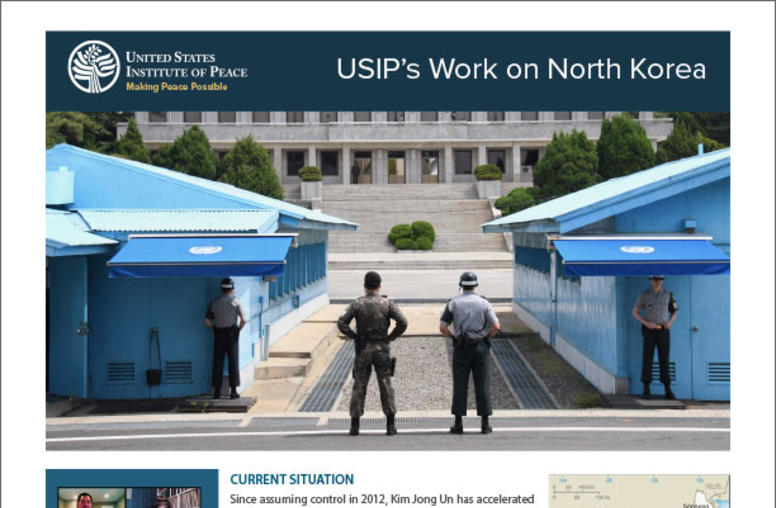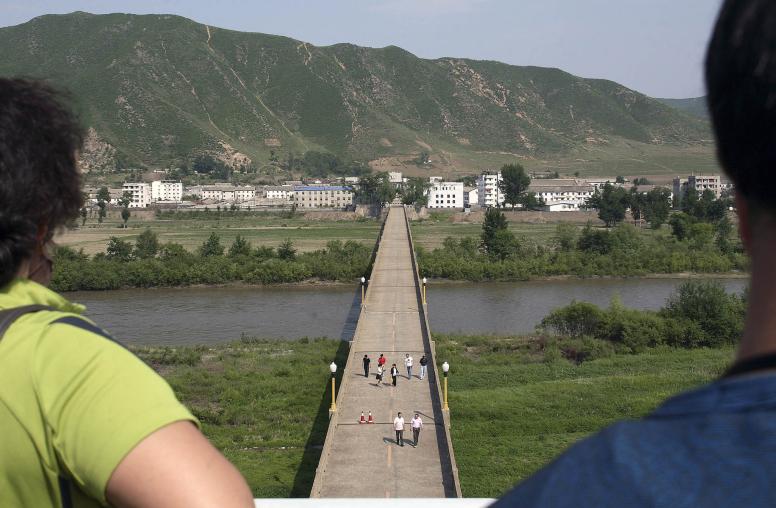North Korea’s Satellite Launch Adds a Spark to Already Simmering Tensions
The launch threatens the future of a 2018 military agreement meant to reduce risk of conflict on the Korean Peninsula.
Tensions on the Korean Peninsula are simmering again as a result of North Korea’s launch of a military reconnaissance satellite, which prompted South Korea to lift restrictions on reconnaissance activities imposed by the 2018 inter-Korean Comprehensive Military Agreement (CMA). The satellite, which was launched on November 21, utilized ballistic missile technology in violation of multiple United Nations Security Council resolutions. The Biden administration, NATO Secretary General Jens Stoltenberg and the G7 foreign ministers swiftly condemned the launch.

USIP’s Frank Aum examines the fallout from the satellite launch.
What provoked the latest tensions on the Korean Peninsula?
Aum: On November 22, North Korea announced that it successfully placed a military reconnaissance satellite into orbit after conducting a rocket launch. Although it is not clear yet whether the satellite’s communications and surveillance capabilities are operational, North Korean state media reported that Kim Jong Un had viewed images of U.S. military bases in the Pacific captured by the satellite. It is also unclear whether Russian cooperation or technology contributed to the success of the satellite placement given that Vladimir Putin’s offer to assist Kim with satellite technology during their summit only occurred two months earlier.
The satellite, if operational, can help improve North Korea’s missile targeting, which enhances the threat against the United States and its allies. However, the gains in North Korea’s military situational awareness from the satellite could also help reduce the risk of inadvertent conflict by providing North Korea greater clarity about U.S.-South Korea military movements.
How have the United States and the United Nations responded to the satellite launch?
Aum: The U.N. secretary-general and the United States both condemned the satellite launch as a violation of U.N. Security Council resolutions that prohibit North Korea’s use of ballistic missile technology. However, the dysfunction at the U.N. Security Council stemming from Russia’s invasion of Ukraine means that the Security Council will be unable to adopt another resolution against North Korea over a Russian veto, so response measures will be taken at the bilateral, trilateral or minilateral level.
The United States is coordinating with South Korea and Japan on potential responses, with South Korea requesting additional bilateral and trilateral military drills. Prior to the satellite launch, the three countries deployed Aegis destroyers near the planned flight path to detect and track the launch and share information jointly.
How has South Korea responded?
Aum: For its part, South Korea, calling North Korea’s launch a violation of the 2018 CMA, partially suspended the agreement by lifting restrictions on reconnaissance activities along the inter-Korean military demarcation line. South Korean Defense Minister Shin Won-sik had previously expressed concerns about the CMA’s restrictive impact on South Korea’s surveillance abilities and later warned about its partial suspension if North Korea proceeded with the satellite launch.
The two countries signed the CMA in September 2018 during then-South Korean President Moon Jae-in’s visit to Pyongyang, when inter-Korean and U.S.-North Korean negotiations had generated more favorable relations. The agreement established various measures for reducing military tensions, including creating no-fly zones along the border, prohibiting most military drills and maneuvers near the land and sea borders, requiring the removal of guard posts along the border, and demilitarizing the Joint Security Area.
What has North Korea’s response been to South Korea’s actions?
Aum: In response to the partial suspension, North Korea announced its own complete scrapping of the CMA and said it would resume “all” related military activities. Today, North Korea began rebuilding guard posts and reintroducing firearms along the border. It is possible that South Korea may expand the suspension or fully suspend the CMA to match the North Korean moves. Both sides had previously accused each other of violating the CMA, including through North Korean coastal artillery drills and joint U.S.-South Korea exercises.
North Korea plans to launch additional satellites next year, which will enhance its military situational awareness even further but could also lead to more aggressive alliance countermeasures in response. The advances in North Korean military capabilities and alliance countermeasures since the end of diplomatic negotiations in 2019 have increased security tensions, arms racing and the potential for conflict on the Korean Peninsula and in the region, and it will require a significant shift in policy direction by one or both sides to change the current, dangerous course.



